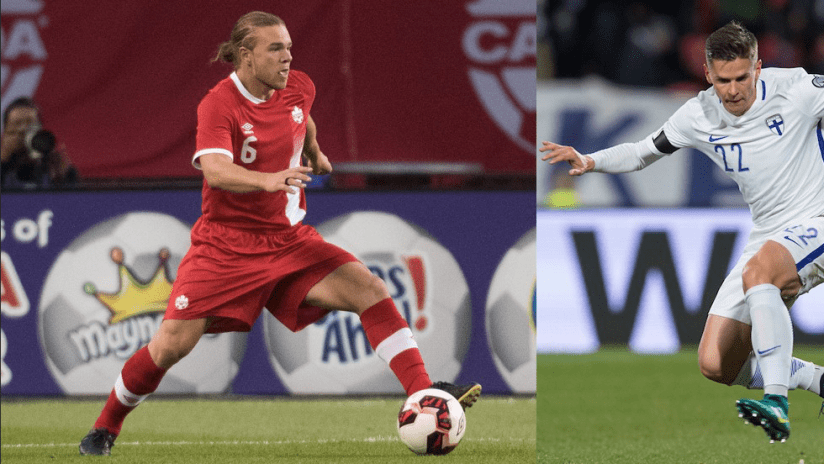Breaking down the details of this new international tournament
Samuel Piette and Jukka Raitala joined their respective national teams during the international break this week, and if both players are used to representing their countries, this time around, they’ll do so in a brand-new competition: the Nations League.
What is the Nations League?
The Nations League, for those unfamiliar with the new tournament, was invented to bring a little more meaning to the international friendly games. Football associations around the world were under the impression that friendly games just didn’t provide the adequate competition for national teams.
So, the Nations League was brought about to not only somewhat replace international friendlies, but also to improve the quality and standing of national team football.
After UEFA announced the creation of the Nations League, Concacaf followed suit shorty after. Let’s dive into the details.
UEFA Nations League
All 55 UEFA member teams are separated into four different leagues: A, B, C, or D, with league A featuring the highest ranked teams in Europe, and league D the lowest.
Here is a breakdown of what the first Nations League will look like for the Europeans.
League A
Group A1: Germany, France, Netherlands
Group A2: Belgium, Switzerland, Iceland
Group A3: Portugal, Italy, Poland
Group A4: Spain, England, Croatia
League B
Group B1: Slovakia, Ukraine, Czech Republic
Group B2: Russia, Sweden, Turkey
Group B3: Austria, Bosnia and Herzegovina, Northern Ireland
Group B4: Wales, Republic of Ireland, Denmark
League C
Group C1: Scotland, Albania, Israel
Group C2: Hungary, Greece, Finland, Estonia
Group C3: Slovenia, Norway, Bulgaria, Cyprus
Group C4: Romania, Serbia, Montenegro, Lithuania
League D
Group D1: Georgia, Latvia, Kazakhstan, Andorra
Group D2: Belarus, Luxembourg, Moldova, San Marino
Group D3: Azerbaijan, Faroe Islands, Malta, Kosovo
Group D4: FYR Macedonia, Armenia, Liechtenstein, Gibraltar
What’s interesting about the UEFA Nations League is that, just like the top European football leagues, it features promotion and relegation. Meaning the four worst teams of each group will be relegated to a lower league (except for group D of course), while the four best teams will be promoted to a higher league. The four group winners in League A will enter a tournament, featuring semifinals and a final, to determine the first ever winner of the UEFA Nations League.
More importantly, the UEFA Nations League provides a different avenue to qualifying for the 2020 European championship. The equation is simple: the top two teams of 10 qualifying groups for Euro 2020 will qualify automatically. The last four spots will be decided by a 16-team playoff, featuring the top four teams in each league in the UEFA Nations League. If one of those teams has already qualified, the next team in line enters the playoff, and so forth.
Concacaf Nations League
The Concacaf’s version will first feature a qualifying phase to determine which teams are placed in which league. Each team will play four qualification matches, and based on the standings afterwards, teams will be divided into three different leagues for the inaugural edition of the Concacaf Nations League, with four different groups in each of them.
Similarly to the UEFA Nations League, the Concacaf’s version will also feature promotion and relegation between different leagues, and it will also become a part of the qualifying process for the 2019 Concacaf Gold Cup, which was expanded from 12 to 16 teams.
The best team in each group will be promoted to a higher league, while the four group winners in League A will enter a tournament, featuring semifinals and a final, to determine the first ever winner of the Concacaf Nations League. The four worst teams in each group will be relegated to a lower league.
Who is in?
There are 41 member states in Concacaf. Six of those have already cemented their position in League A and the 2019 Gold Cup, by participating in the Hex, which is the final round of World Cup qualifying for Concacaf countries. With Guatemala’s football association having been suspended by FIFA, that leaves 34 teams fighting for qualification, including Canada.
From the 34 teams participating in the four-game qualification phase, the first six will qualify to League A. After, the following 16 international selections will qualify to League B. The 12 remaining teams will be put into League C.
The first 10 teams in the standings after qualification will also qualify for the 2019 Concacaf Gold Cup, along with the six members of the Hex.




